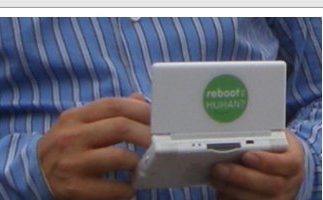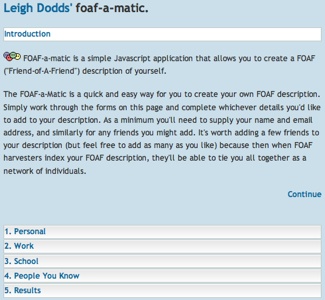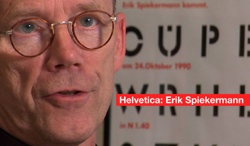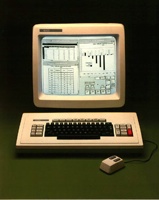 The Friend of a Friend (FOAF) project
The Friend of a Friend (FOAF) project
I really need to “get out more”, since I’ve only just now discovered the Friend of a Friend project (FOAF), and I LOVE it!
The Friend of a Friend (FOAF) project is creating a Web of machine-readable pages describing people, the links between them and the things they create and do.
Say what?
FOAF is an important part of the so-called semantic-web, and FOAF is just a so-called RDF specification of who you are. RDF (Resource Description Framework) is one of the basic technologies of the semantic web, and it’s nothing more (or should I say less) than an XML schema condoned by the W3C for describing resources.
Think of RDF as “the mother of all links”, RSS and Atom actually uses RDF.
The problem with links
So what is that RDF does better than the tradtional link?
When you create a link, you rarely remember to provide important information about what it is that you actually link to. At best you provide an ALT attribute (description) to an image tag. Google actively uses the ALT tag when indexing images, but if the link to an image contained more information, eg. semantics, Google could do a much better job.
Semantics means that you provide information about content and context, not just a link to it. You could call that metadata, abstracts or just “data”.
Many CMSes uses the URI of posts to provide some semantics, it’s often called SEO (search engine optimisation), the URI of this post has FOAF in it, meaning that a link to this article indeed contains some semantics.
A common standard for the WordPress CMS is that it uses year, month, day and the title of the post to generate the URI.
The problem is that this information should be provided in a structured, machine readable and – most importantly – open format, in order to make it possible to provide semantics.
I actually despise the concept of SEO, since it amounts to cheating, the only valid SEO is:
“provide interesting content”
A semantic “you”
A number of standards for providing semantics exists, one of the most interesting, especially in this day and age of social media, is the FOAF format.
FOAF is a format that describes you and your connections to provide semantics about people (you) and your connections (friends), in a standardised way, using RDF.
The FOAF file contains information about who you are, how to contact you, but most interestingly it contains links to your friends, and their FOAF files.
The beauty of FOAF is, that all you have to do, is:
- Create a FOAF file, for instance using FOAF-a-matic
- Put it on a server
- Provide the URI
- Make sure that it can be found by others (e.g. by posting a link on a page you know is indexed)
Chances are that the FOAF spiders will have a feast on your FOAF, sooner rather than later.
Create your FOAF file
It’s quite simple to create a FOAF file, all you need to do is go to FOAF-a-matic, fill in a number of fields, generate the FOAF file, copy it to a text-editor, publish it on your web-site.
Below is a screenshot of the FOAF-a-matic page.
Take back your profile, it’s…YOURS!
No need to register with social networking sites, your profile is YOURS.
Who owns the information about “who you are”? You do! Should that information be made available in an open format? You bet! RDF and FOAF is the way to go.
And don’t take my word for it, just take a look at the people who are promoting and developing RDF and FOAF…
So how did the chicken cross the road
I’ll provide you with the story about how I found FOAF, since it’s interesting to say the least.
My good buddy Sebastian Lund just recently set up his blog, Silence is deafening, and I’m looking forward to following it, he’s using a beautiful theme, the Dilectio Theme, developed by Design Disease.
Design Disease has a number of free WordPress themes available, and you can test them, when I tried that, their “Lorem Ipsum” turned out to be an article by no other that TBL, timbl, Tim Berners-Lee, Mr. Web himself, and he was writing about blogging and FOAF…
So:
- I follow Sebastian Lund using Jaiku
- I noticed that Sebastian has created a new blog because I’m indirectly subscribed to his RSS feed through Jaiku.
- I check it out
- I like his theme
- I jumped to the theme developer, Design Disease
- I stumbled upon an article by TBL
- I jumped to TBL’s blog
- I jumped to FOAF-project.org
- I made my first FOAF file using FOAF-a-matic
What an untangled web we’re weawing.
Now I need to think of a good URI for my FOAF file, TBL suggests this:
A lot of people have published data about themselves without using a URI for themselves. This means I can’t refer to them in other data. So please take a minute to give yourself a URI. If you have a FOAF page, you may just have to add rdf:about=”” and voila you have a URI http://example.com/Alan/foaf.rdf#ABC. (I suggest you use your initials for the last bit). Check it works in the Tabulator.
Ready, steady FOAF
So what are you waiting for? Create your own FOAF file, and start sharing.
And now I’m moving on to explore Tabulator, more on that later…









